Foundation double crochet (FDC) is a technique that allows you to create clean, even, and consistent stitches without having to use a foundation chain.
This technique is perfect for starting a new crochet project and can be used for a variety of different patterns and projects.
With FDC, you can work your foundation chains and your first row of double crochet stitches in one step, which makes counting the stitches much easier than counting a row of chain stitches.
This crochet technique is a great alternative to the traditional method of starting a crochet project with a foundation chain, as it produces a more stable and even foundation for your work.
I love using the foundation double crochet stitch in my crochet projects. It creates a clean and even base row that is perfect for projects with a long foundation row.
Similar to working into the back bumps on a chain, it also leaves a nice, finished edge on the bottom that makes it easier to work a border into.
Learning how to do foundation double crochet can seem intimidating at first, but with the right instructions and a little bit of practice, it can be a great way to take your crochet skills to the next level.
In this article, I will guide you through the stitch step-by-step, provide tips and tricks for mastering the technique, and offer examples of how you can use it in your crochet projects.
Abbreviations
When working with foundation double crochet, it’s important to understand some of the common abbreviations used in crochet patterns.
Here are a few abbreviations you may come across:
- FDC: foundation double crochet
- dc: double crochet
- ch: chain
- sl st: slip stitch
- st: stitch
- yo: yarn over
When working with FDC, you’ll start with a slip knot, then chain just three stitches before you start working the first foundation double crochet. From there, you’ll work each subsequent FDC into the base of the previous stitch.
Before you dive into learning the foundation double crochet, it’s a good idea to be familiar with the basics of the double crochet stitch. If you need a quick review or if you’re new to the double crochet stitch, check out my step-by-step tutorial on the double crochet stitch!
Overall, starting your crochet projects with the foundation double crochet can be a great way to create a strong, even foundation for your crochet projects.
With a bit of practice, you’ll be able to master this technique and create beautiful, professional-looking pieces.
Foundation Double Crochet — Step-by-Step Instructions
Step 1: Make a slip knot and chain 3.
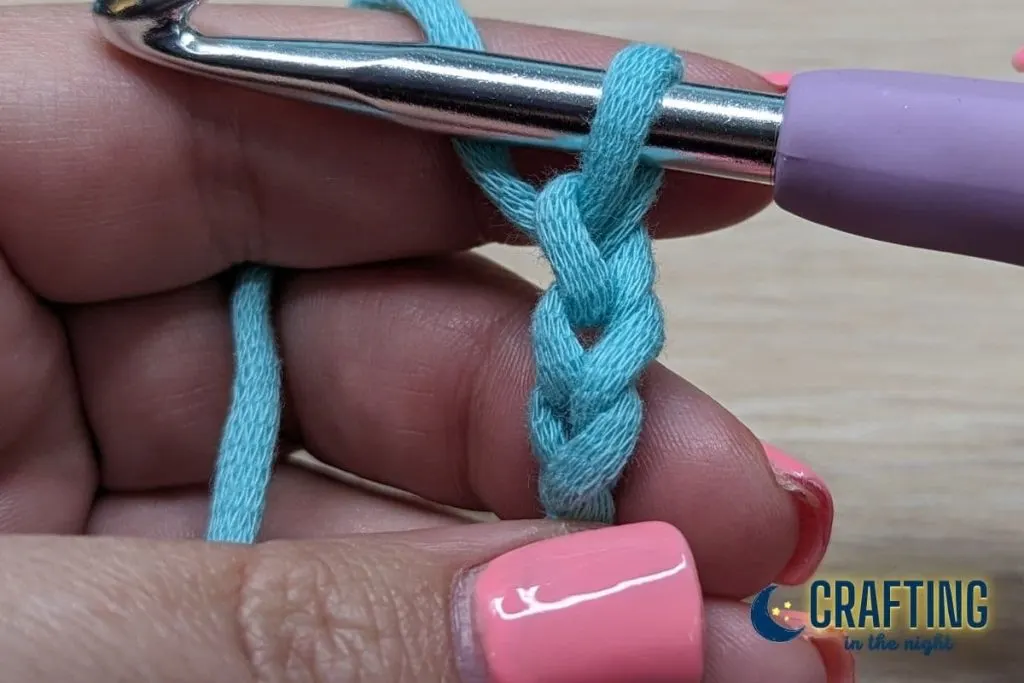
Step 2: Yarn over and insert the hook into the third chain from the hook, under both top loops.
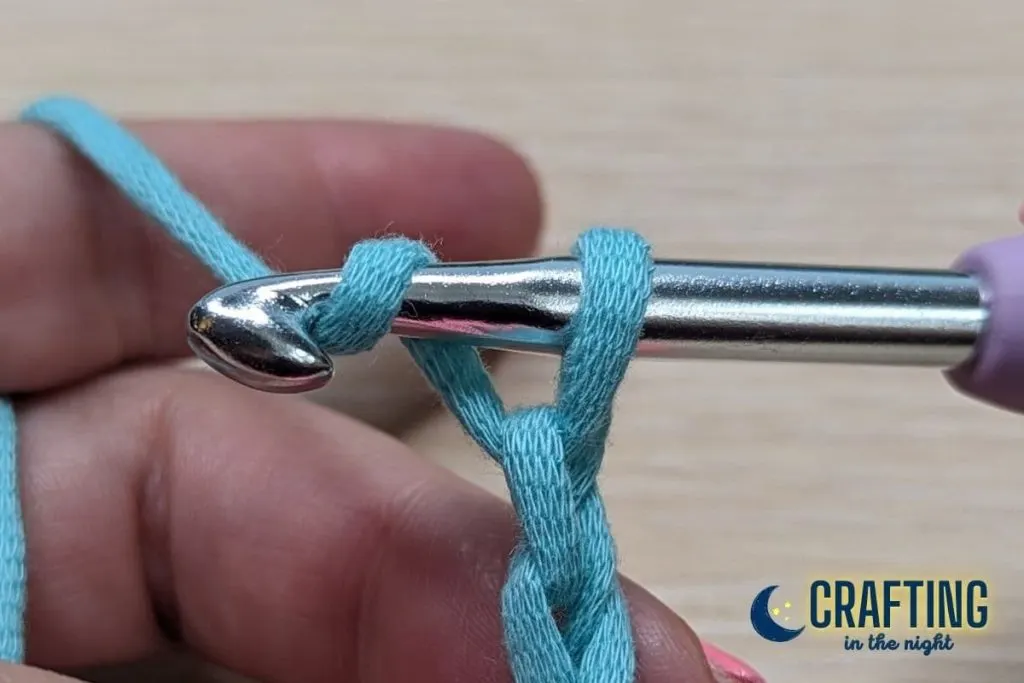

Step 3: Yarn over and pull up a loop.

Step 4: Yarn over and pull through one loop.
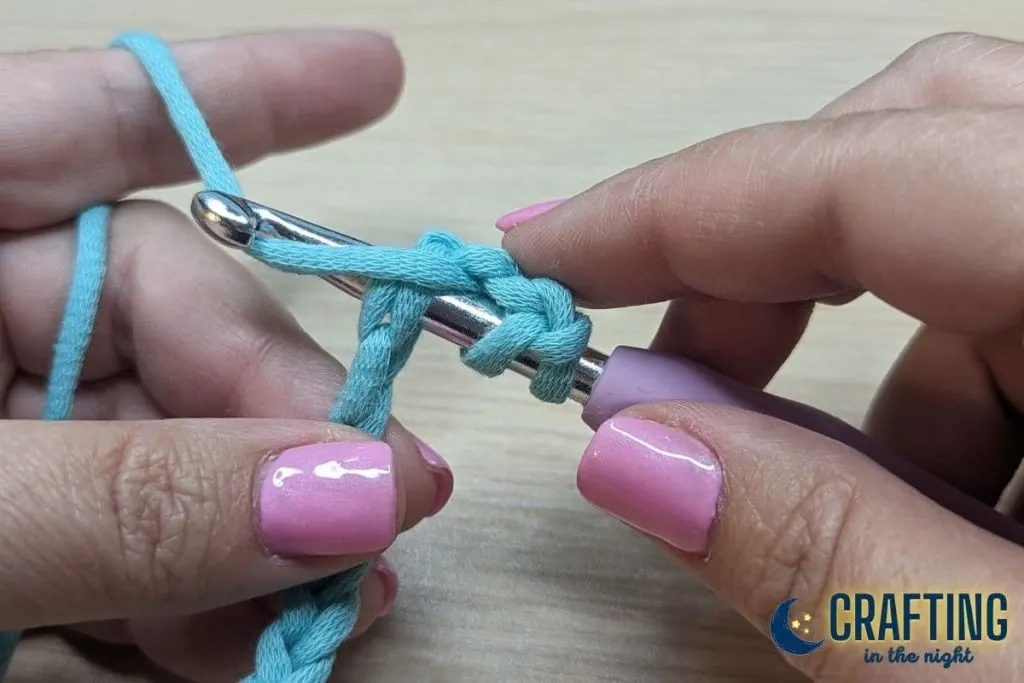
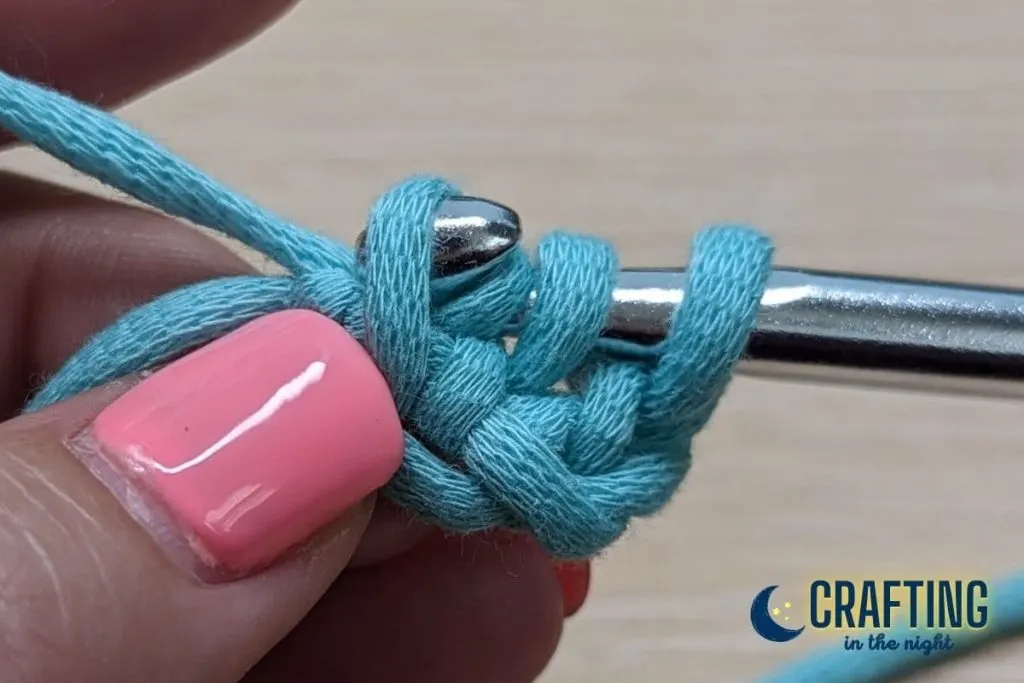

Step 5: Yarn over and pull through two loops.

Step 6: Yarn over and pull through two loops.


Step 7: Yarn over and insert your hook under two loops of the stitch formed by our first yarn over and pull through.

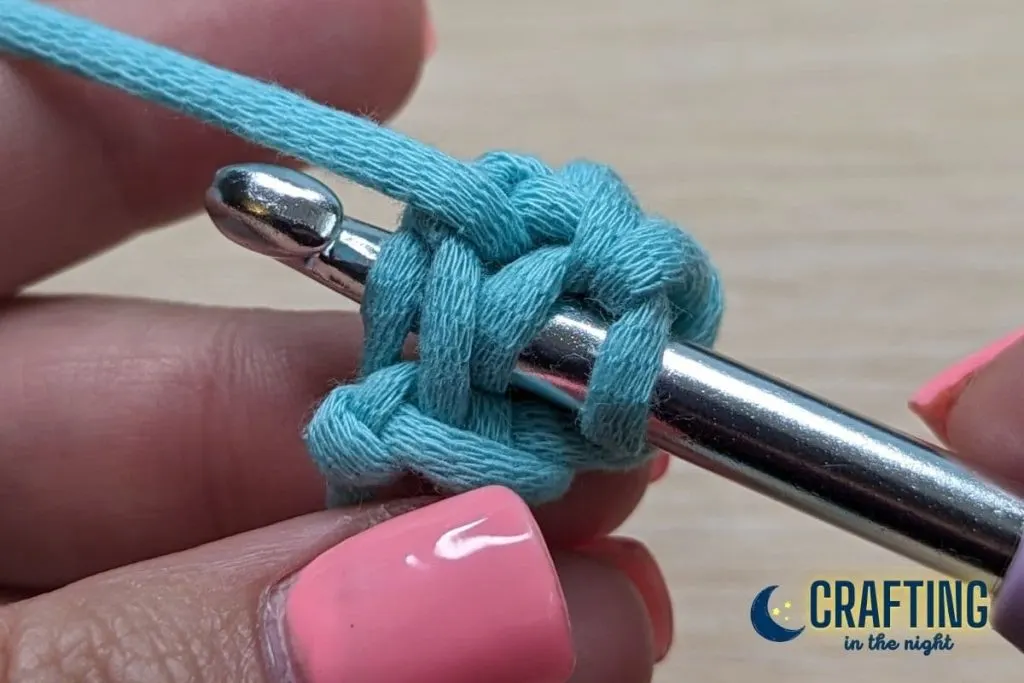
💡 TIP: The correct stitch can be hard to identify when you are first learning this stitch, but with practice, it will get easier and easier. The stitch looks somewhat like a single crochet.
Step 8: Yarn over and pull up a loop.

💡 TIP: When pulling up this loop, be sure to pull it up as tall as the other two stitches. If this loop is too short, your foundation will start to curl or curve instead of being straight.
Step 9: Yarn over and pull through one loop.
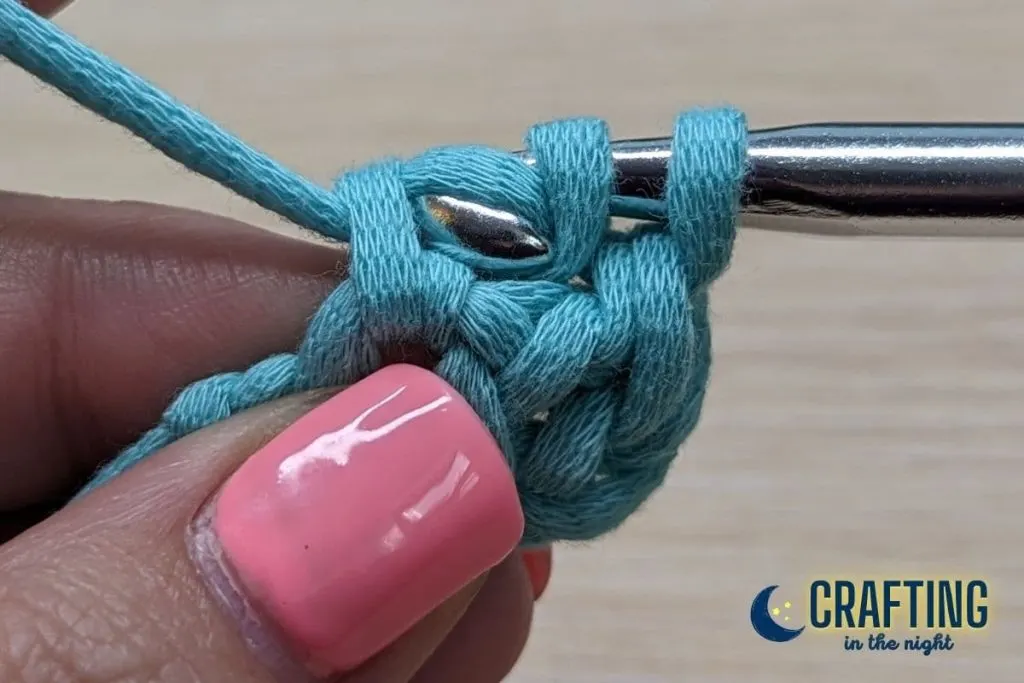
Step 10: Yarn over and pull through two loops.

Step 11: Yarn over and pull through the last two loops.
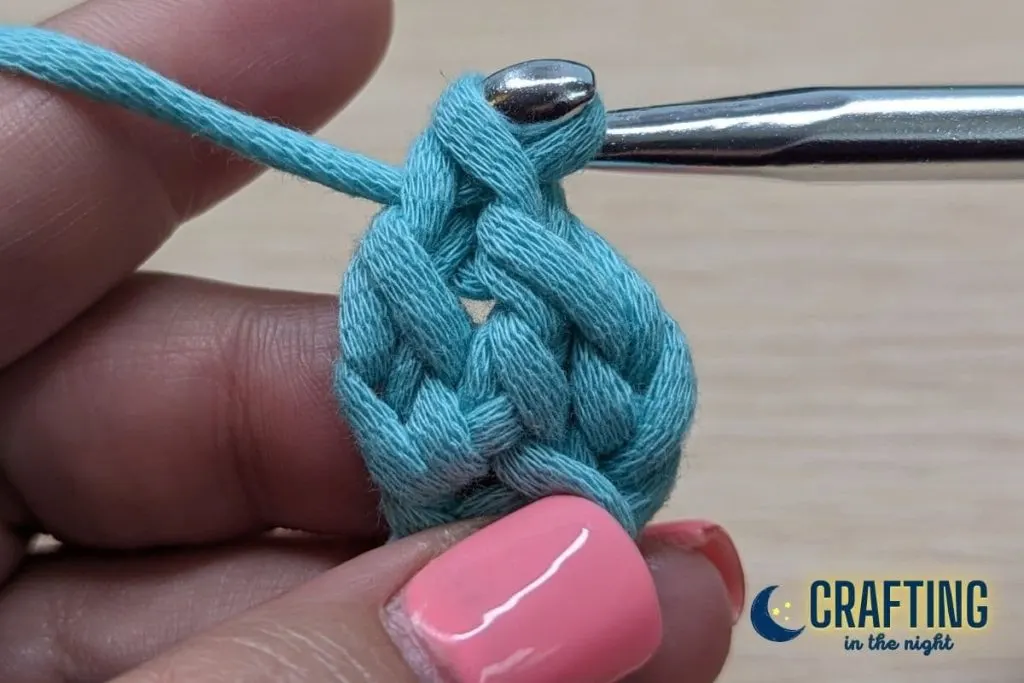
Repeat steps 7–11 until your chainless foundation double crochet is as long as you need it for your project. Each time you start a new foundation double crochet, you will want to be sure to locate the correct spot to work into.
Each stitch creates a “v” with the first yarn over and pull-through through one loop. It can be tricky at first, but with practice, you’ll be able to quickly locate it!

Fixing Curling in Foundation Double Crochet
Once you get the hang of where to work your stitches, the foundation double crochet works up pretty quickly.
This technique is especially great for projects like blankets and scarves where you may not be sure how many chains you’ll need based on your yarn and hook size.
Sometimes, though, you’ll notice your foundation row curling.

Curling is caused by the first stitch of each FDC being too short compared to the rest of the stitches.
The amount of curling depends on how tight these stitches are.
In the photo above, I purposefully made the sample curl pretty sharp for illustration, but your curl is likely going to be more subtle.
How to Fix the Curl
Each time you work step 8, where you insert your hook into the base of the first stitch from the previous FDC, you’ll want to ensure you bring your loop up even in height with your other two stitches.
If you ensure that your crochet hook is held horizontally and all three stitches on the hook are the same height, this will help keep your foundation straight.
Curling is typically caused by having a shorter base chain, often caused by yarning over and pulling through when your hook is at a downward angle.

If you have completed a large number of FDC stitches before noticing that your project is curling, you have a few decisions to make:
You can either frog (rip out) your stitches back to where the curl starts, OR you can see if your yarn has enough stretch to straighten itself out.
If your yarn has some give to it, adding the second row will help straighten it out some, and then blocking your crochet project can help provide additional straightening.
If it is really bothering you, though, it may be best to just rip back to before the curl and start again.
Since this is the foundation, it forms the base for the rest of your project, and fixing it just gives you more practice with the stitch!
Changing Colors in Foundation Double Crochet
When working on a crochet project, you may want to switch colors to create a pattern or design.
Changing colors in foundation double crochet is not common, but it is also not difficult, and it can add a lot of visual interest to your work.
To change colors in the foundation double crochet, follow these steps:
Step 1: Work the last stitch until you have two loops on your hook.
Step 2: Drop the old color and pick up the new color.
Step 3: Yarn over with the new color and pull through both loops on your hook to complete the stitch.
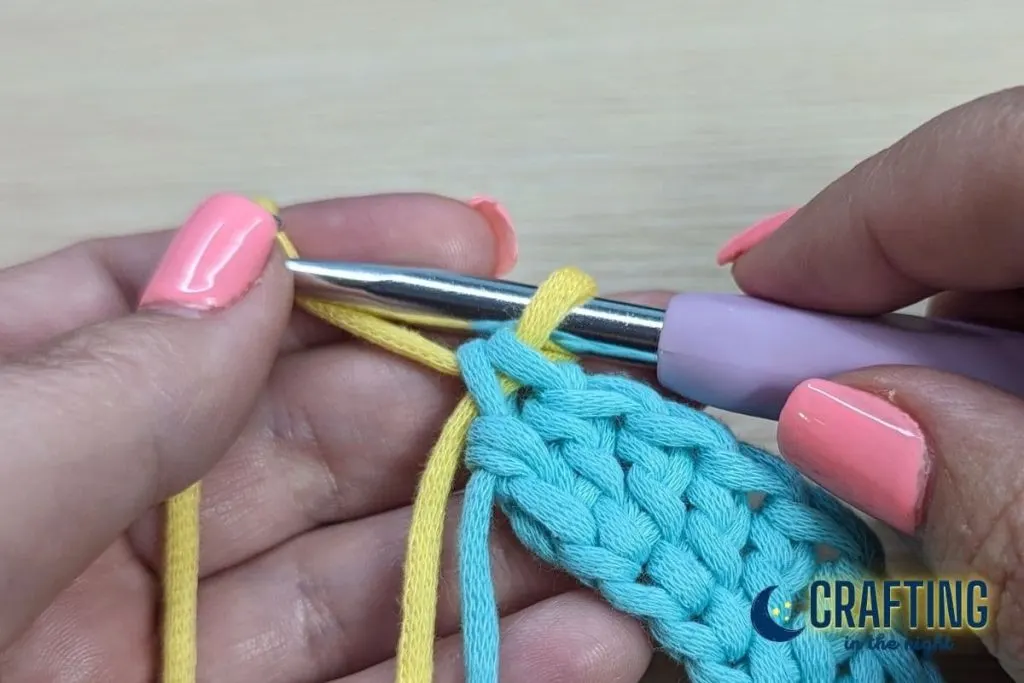
Step 4: Continue working with the new color just as you did above.

It’s that simple! You can repeat this process as many times as you like to create vertical stripes or other color patterns.
If your first row of double crochets does have color changes, foundation double crochet is a great option because it ensures the entire stitch changes color versus using a starting chain.
Counting FDC Stitches
Counting foundation double crochet stitches can be confusing. There are a few things to consider.
When Counting Stitches, Does the Starting Chain 3 Count as a Stitch?
There are a few different ways to do a turning chain for double crochet, and, depending upon which method you use, the starting chain 3 may or may not count as a stitch.
For the swatches used in this article, the starting chain 3 DOES count as the first double crochet stitch.
Using Chainless Foundation Double Crochet in Patterns
If you are trying the foundation double crochet for the first time, one thing that can be confusing is figuring out how many FDCs you need when the pattern gives instructions for a long starting chain.
If your pattern says, “Chain 125 and double crochet in the fourth chain from the hook,” how many foundation double crochet stitches do you need?
This will really depend on whether the pattern writer is counting the chain 3 as your first double crochet. If so, you would need 122 FDC stitches. If not, you would need 121 FDC stitches
Benefits of Using a Foundation Double Crochet
- Greater Flexibility: Foundation double crochet provides a more flexible and stretchy foundation compared to a traditional chain, making it ideal for projects like scarves, blankets, or garments where stretch and drape are important.
- Eliminates the Need for a Separate Foundation Chain: With FDC, you create the foundation chain and the first row of double crochet stitches simultaneously. This eliminates the need for a separate foundation chain, streamlining your crochet process.
- Improved Consistency: Foundation double crochet produces a more consistent tension and appearance across your project, ensuring that the initial row matches the rest of your work, resulting in a polished and even finish.
- Time and Yarn Efficiency: Since you create both the foundation and the first row of stitches in one step, foundation double crochet can save time and yarn compared to the traditional method of making a foundation chain and then working into it.
- Reduced Curling: Foundation double crochet tends to reduce the curling that can occur with some crochet projects, helping to keep the edges flatter and more stable.
Tips & Tricks
Crocheting with foundation double crochet can be a bit tricky at first, but with some practice, it can become second nature.
Here are a few tips and tricks that I have found helpful when working with this stitch:
- Take Your Time: First and foremost, take your time when working on the foundation chain. It can be easy to get frustrated and rush through it, but a neat and even foundation chain is key to a successful project.
- Watch My Tutorial: If you are new to foundation double crochet, I highly recommend watching the video tutorial in this article where I walk you step-by-step through the process.
- Use a Larger Hook: When working on a project that requires a lot of foundation double crochet stitches, consider using a larger crochet hook. This will help to speed up the process and make it easier to work with.
- Loosen Your Tension: If you find that your stitches are too tight, try using a larger hook or loosening your tension. Foundation double crochet should be stretchy and flexible, so it’s important to find the right balance.
- Adjust the Number of Starting Stitches: Don’t be afraid to adjust the number of starting stitches. Add a few extra or leave out a few stitches if you need to adjust the size of your project. Foundation double crochet is a great stitch for making adjustments on the fly.
Frequently Asked Questions
What is the difference between foundation double crochet and foundation single crochet?
Foundation double crochet (FDC) and foundation single crochet (FSC) are both techniques used to create a foundation row of stitches without having to create a chain and then work into it.
The main difference between the two is that foundation double crochet creates a taller stitch than foundation single crochet.
Foundation double crochet creates a row of double crochet stitches while foundation single crochet creates a row of single crochet stitches.
How many foundation chains are needed for a double crochet?
When using foundation double crochet, you only need to create three chains to start your foundation row. This chain will count as the first stitch of your row.
Why is it called chainless foundation double crochet if there is a starting chain?
The foundation double crochet is often called a “chainless” foundation because while you do need to start with three chains, after that there are no chains in the rest of the stitch.
Once they learn it, many crocheters find this stitch much easier than working up a long chain — often near 100 stitches for even small blankets — and then double crocheting into the chain. This stitch combines both of those into one step.
Can foundation double crochet be used in the round?
Foundation double crochet can be used in the round.
To do this, you will need to join your last stitch to your first stitch with a slip stitch and then continue working in the round as usual. Use the tail of your yarn to close the gap between the starting chain and the last foundation double crochet.
There will still be a hole in the center of your work. You can make this smaller by reversing the instructions about curling above.
So, instead of pulling the stitch up high, make the first stitch tight. If you are, however, looking for a completely closed middle, it’s best to do double crochets into a magic circle.
What are some alternative stitches to foundation double crochet?
Some alternative stitches to foundation double crochet include foundation single crochet (FSC), chainless foundation half-double crochet (FHDC), and chainless foundation treble crochet (FTC).
Each of these techniques creates a foundation row of stitches without having to create a chain and then work into it.
Are there any patterns available for foundation double crochet?
You can use a foundation double crochet for any pattern that uses all double crochets for the first row. Most commonly, you’ll see this in patterns for blankets, scarves, hats, and more.
Why do some crocheters prefer to use foundation double crochet?
Some crocheters prefer to use foundation double crochet because it creates a more flexible and stretchy foundation row than traditional chains.
A flexible foundation can be especially helpful when working with projects that need to fit snugly, such as hats or gloves. Additionally, foundation double crochet can save time and eliminate the need for counting chains.
When should you not use foundation double crochet?
You should not use foundation double crochet if your pattern calls for skipping chains in the first row. This method is best suited when the entire first row of a project is comprised entirely of double crochets with no skipped chains and no other stitches worked for the first row.
Why do some FDC patterns use a chain 2 and this pattern uses a chain 3 to start?
Both ways of starting the FDC are valid; however, to write the article, I had to pick one.
I feel that starting with a chain 3 and counting that as the first double crochet makes the most sense for beginners who are learning the foundation double crochet for the first time.

